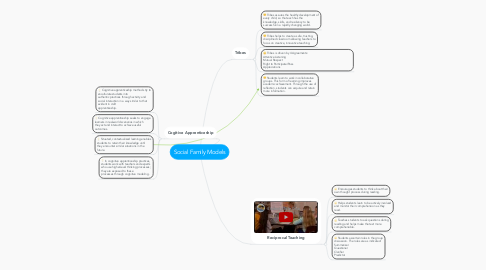Social Family Models
by Esther Rodriguez

1. Cogitive Apprenticeship
1.1. Cognitive apprenticeship methods try to enculturate students into authentic practices through activity and social interaction in a way similar to that evident in craft apprenticeship.
1.2. Cognitive apprenticeship seeks to engage learners in real-world scenarios in which they act and interact to achieve useful outcomes.
1.3. Situated, contextualized learning enables students to retain their knowledge until they encounter similar situations in the future.
1.4. In cognitive apprenticeship practices, students work with teachers and experts who use higher-level thinking processes; they are exposed to these processes through cognitive modeling .
2. Tribes
2.1. Tribes assures the healthy development of every child, so that each has the knowledge, skills, and resiliency to be successful in a rapidly changing world.
2.2. Tribes helps to create a safe, trusting, disciplined classroom allowing teachers to focus on creative, innovative teaching.
2.3. Tribes is driven by 4 Agreements: Attentive Listening Mutual Respect Right to Participate/Pass Appreciations
2.4. Students learn to work in collaborative groups. This form of learning improves academic achievement. Through the use of reflection, students can acquire and retain more information.
3. Reciprocal Teaching
3.1. Encourages students to think about their own thought process during reading.
3.2. Helps students learn to be actively involved and monitor their comprehension as they read.
3.3. Teaches students to ask questions during reading and helps make the text more comprehensible.
3.4. Students ascertain roles in the group discussion. The roles are as indicated: Summarizer Questioner Clarifier Predictor


